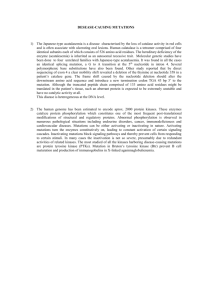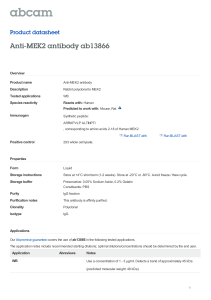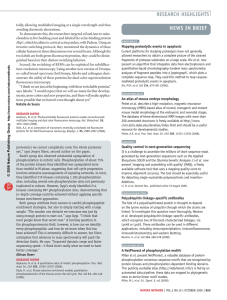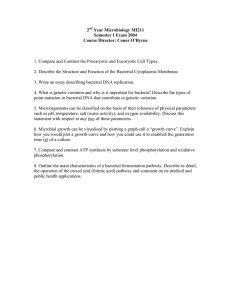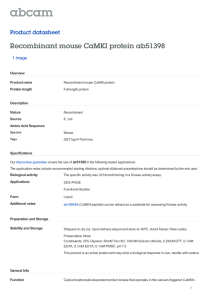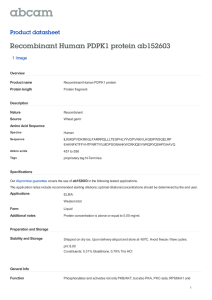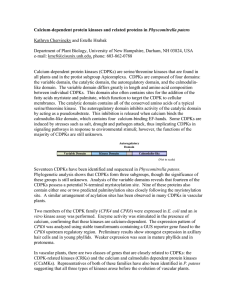Publisher version
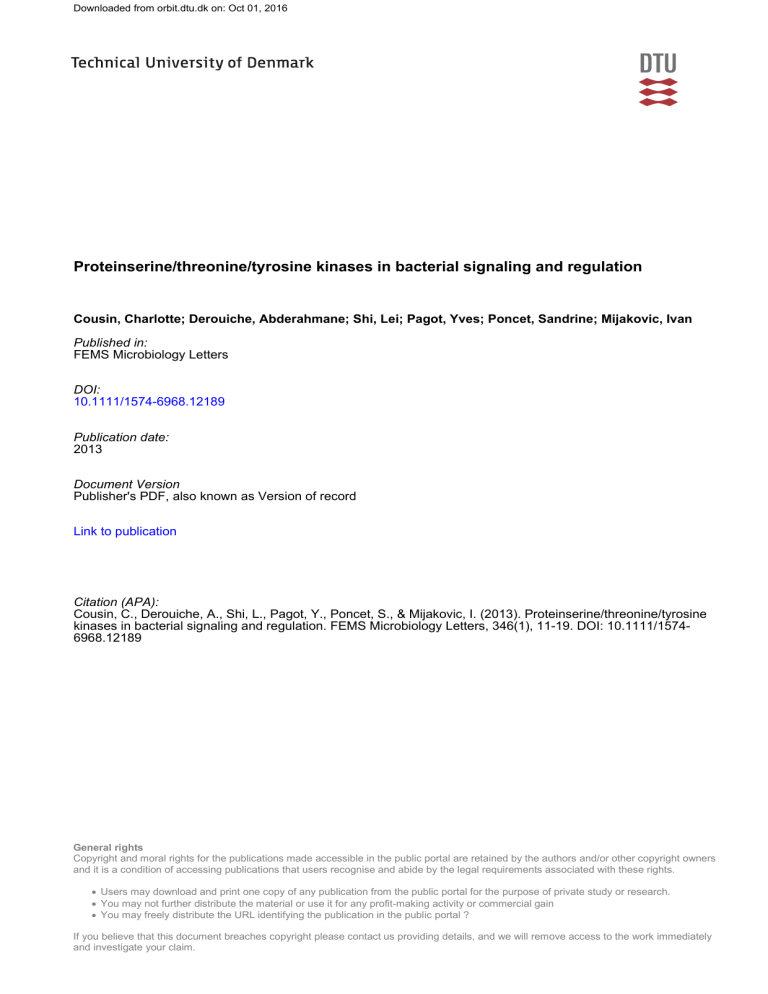
Downloaded from orbit.dtu.dk on: Oct 01, 2016
Proteinserine/threonine/tyrosine kinases in bacterial signaling and regulation
Cousin, Charlotte; Derouiche, Abderahmane; Shi, Lei; Pagot, Yves; Poncet, Sandrine; Mijakovic, Ivan
Published in:
FEMS Microbiology Letters
DOI:
10.1111/1574-6968.12189
Publication date:
2013
Document Version
Publisher's PDF, also known as Version of record
Link to publication
Citation (APA):
Cousin, C., Derouiche, A., Shi, L., Pagot, Y., Poncet, S., & Mijakovic, I. (2013). Proteinserine/threonine/tyrosine kinases in bacterial signaling and regulation. FEMS Microbiology Letters, 346(1), 11-19. DOI: 10.1111/1574-
6968.12189
General rights
Copyright and moral rights for the publications made accessible in the public portal are retained by the authors and/or other copyright owners and it is a condition of accessing publications that users recognise and abide by the legal requirements associated with these rights.
•
Users may download and print one copy of any publication from the public portal for the purpose of private study or research.
•
You may not further distribute the material or use it for any profit-making activity or commercial gain
•
You may freely distribute the URL identifying the publication in the public portal ?
If you believe that this document breaches copyright please contact us providing details, and we will remove access to the work immediately and investigate your claim.
M I N I R E V I E W
Protein-serine/threonine/tyrosine kinases in bacterial signaling and regulation
Charlotte Cousin
1
Ivan Mijakovic
1,2,3
, Abderahmane Derouiche
1
, Lei Shi
1
, Yves Pagot
1,2
, Sandrine Poncet
1
&
1
Institute Micalis UMR1319, INRA, F-78350 Jouy-en-Josas, France;
2
Institute Micalis UMR1319, AgroParisTech, F-78350 Jouy-en-Josas, France; and
3
Department of Chemical and Biological Engineering, Chalmers University of Technology, SE-41296 G oteborg, Sweden
Correspondence : Ivan Mijakovic, MICALIS
UMR 1319, AgroParisTech, CBAI, Route de
Thiverval, F-78850 Thiverval-Grignon, France.
Tel.: +33 1 30 81 45 40; fax: +33 1 30 81 54 57; e-mail: Ivan.Mijakovic@grignon.inra.fr
Received 29 April 2013; revised 30 May
2013; accepted 30 May 2013. Final version published online 19 June 2013.
DOI: 10.1111/1574-6968.12189
Editor: Andre Klier
Keywords phosphoproteomics; protein phosphorylation; development; pathogenic bacteria; regulatory network.
Abstract
In this review, we address some recent developments in the field of bacterial protein phosphorylation, focusing specifically on serine/threonine and tyrosine kinases. We present an overview of recent studies outlining the scope of physiological processes that are regulated by phosphorylation, ranging from cell cycle, growth, cell morphology, to metabolism, developmental phenomena, and virulence. Specific emphasis is placed on Mycobacterium tuberculosis as a showcase organism for serine/threonine kinases, and Bacillus subtilis to illustrate the importance of protein phosphorylation in developmental processes. We argue that bacterial serine/threonine and tyrosine kinases have a distinctive feature of phosphorylating multiple substrates and might thus represent integration nodes in the signaling network. Some open questions regarding the evolutionary benefits of relaxed substrate selectivity of these kinases are treated, as well as the notion of nonfunctional ‘background’ phosphorylation of cellular proteins. We also argue that phosphorylation events for which an immediate regulatory effect is not clearly established should not be dismissed as unimportant, as they may have a role in cross-talk with other post-translational modifications.
Finally, recently developed methods for studying protein phosphorylation networks in bacteria are briefly discussed.
Introduction
In the very first study that detected protein phosphorylation (Fischer & Krebs, 1955), the tremendous regulatory potential of this post-translational modification (PTM) was immediately recognized. As argued by Hunter (2012), its versatility and reversibility have been the key factors behind the emergence of protein phosphorylation as one of the key PTMs in cellular signaling and regulation.
Accordingly, it has been suggested by Pearlman et al.
(2011) that the advantage of reversibility may drive the evolution of phosphorylation sites from negatively charged aspartate and glutamate residues at key positions in protein structures where there is an advantage to be gained if their negative charges can become facultative.
The authors demonstrated this principle on the example of phosphorylatable serine, threonine, and tyrosine residues in Topo II, enolase, and Raf protein structures, respectively. These phospho-residues have the capacity to form stabilizing salt bridges formed by glutamate and aspartate residues in the ancestral versions of the proteins
(Pearlman et al.
, 2011). This evolutionary principle is of course not universal for all phosphorylation sites, especially not for those where phosphorylation inactivates the proteins. Phosphorylation of proteins in Eukarya is known to be quite an abundant phenomenon. In humans, over 500 protein kinases have been detected.
They interact with substrates (and each other) to create a large signaling network that regulates the cell cycle and myriad other housekeeping processes. Anomalies in this complex networks can lead to cancer development (Brognard & Hunter, 2011) and other types of cellular malfunction, and this incited a very exhaustive scrutiny by the scientific community. Most protein kinases in
Eukarya phosphorylate serine, threonine, or tyrosine residues and belong to the structural family described by Hanks et al.
(1988). They are therefore referred to as Hanks-type kinases, sharing a common fold in their cytosolic kinase
FEMS Microbiol Lett 346 (2013) 11–19 ª 2013 Federation of European Microbiological Societies
Published by John Wiley & Sons Ltd. All rights reserved
12 C. Cousin et al.
domain. The receptor-type kinases contain the cytosolic kinase domain attached to a transmembrane helix, connecting to an extracellular ligand binding domain, which is responsible for kinase activation upon ligand binding.
The kinase domain can also be soluble, and in this case, the kinases are usually activated via phosphorylation by kinases further ‘upstream’ in the cascade.
In bacteria, first evidence of protein phosphorylation emerged several decades later than in Eukarya (Garnak &
Reeves, 1979). Historically, in the initial phase of research on bacterial protein phosphorylation, the kinases that came to the fore were the histidine/aspartate kinases of the two component systems (TCS). Early on, these systems were regarded as the major signal transduction device in bacterial cells (Casino et al.
, 2010). The first TCS component, the histidine kinase is stimulated by a particular environmental or intracellular signal, and it autophosphorylates on a key histidine residue. The cognate response regulator then uses this phospho-histidine as a substrate for its own autophosphorylation (on an aspartate residue). This second autophosphorylation activates the ‘response’ function of the system: Most response regulators are DNA-binding proteins that trigger expression from target promoters. To maintain a faithful flow of information through the signaling pathway, any given pair of histidine kinase and response regulator must selectively recognize each other, and must not cross-react with other TCS. In other words, the systems must be insulated via specific protein – protein interactions between the kinase and response regulator in a given TCS (Podgornaia & Laub, 2013). This dedication of a single TCS to one function made the functional dissection of TCS a fairly straightforward task. As argued by Lazebnik
(2002), biologists like to inactivate system components, look for loss of function, and assign the lost function to the inactivated component. This approach works marvelously well for TCS. To cite one famous example, the deletion of the TCS CheA/CheY involved in chemotaxis of Halobacterium salinarium led to a complete loss of chemotaxis
(Rudolph & Oesterhelt, 1996). While the physiological role of TCS can thus be successfully characterized, other phosphorylation systems in bacteria are less amenable to the above-mentioned approach. Sequencing of bacterial genomes revealed that they contain numerous Hanks-type kinases that are mainly responsible for serine and threonine phosphorylation in bacteria (Pereira et al.
, 2011). These kinases are sometimes referred to as ‘eukaryotic-like’, but in the absence of any convincing evidence that their origin in bacteria is horizontal transfer from Eukarya, this seems ill advised. Tyrosine phosphorylation also exists in bacteria, and it is mainly catalyzed by the so-called BY-kinases, a bacteria-specific family of kinases without any counterparts in Eukarya (Grangeasse et al.
, 2007). A distinguishing feature that makes these two families very different from TCS is that a single kinase can phosphorylate many substrates, and thus inactivation of a single kinase often produces a complex pleiotropic phenotype. This will be exemplified in the following paragraph by the multi-substrate kinases
PtkA from Bacillus subtilis (Petranovic et al.
, 2007; Jers et al.
, 2010; Kiley & Stanley-Wall, 2010) and PknB from
Mycobacterium tuberculosis (Mir et al.
, 2011; Roumestand et al.
, 2011; Gee et al.
, 2012).
Serine/Threonine/Tyrosine kinases: hubs in a complex regulatory network?
Recent site-specific phosphoproteome studies have revealed the presence of numerous phosphorylated serines, threonines, and tyrosines in bacterial cells (Macek
& Mijakovic, 2011). First reported site-specific phosphoproteomes were those of the model bacteria B. subtilis
(Macek et al.
, 2007) and Escherichia coli (Macek et al.
,
2008). Their phosphoproteomes turned out to be of average size, with about 100 phosphorylated proteins per cell.
The smallest phosphoproteomes were detected in the genus Pseudomonas with 56
–
57 detected phosphopeptides per species (Ravichandran et al.
, 2009) and Mycoplasma pneumoniae with 63 reported phosphorylated proteins
(Schmidl et al.
, 2010). The largest dataset so far was reported for M. tuberculosis , with over 300 phosphoproteins (Prisic et al.
, 2010). The intracellular pathogen
M. tuberculosis possesses 11 Hanks-type kinases, which is a comparatively large set with respect to most of the sequenced bacterial species. Consequently, it is the best studied bacterial model with respect to their physiological roles. Hanks-type kinases of M. tuberculosis have been shown to participate in growth regulation, by influencing division and envelope synthesis (Molle & Kremer, 2010).
A major player in this respect is the peptidoglycanresponsive kinase PknB (Mir et al.
, 2011), that activates the peptidoglycan assembly by phosphorylating the key biosynthetic protein MviN (Gee et al.
, 2012). PknB has other proteins substrates, some of which contain forkhead-associated domains.
Regarding its substrate
Rv0020c, it has been shown that the interaction between the kinase and the substrate can be modulated by the extent and pattern of substrate phosphorylation (Roumestand et al.
, 2011). Another Hanks-type kinase from
M. tuberculosis , PknE, is involved in adaptive stress response (Kumar et al.
, 2013). It also promotes intracellular survival by antagonizing the apoptotic pathway of macrophages (Kumar & Narayanan, 2012). This exemplifies the participation of kinases in biochemical warfare between intracellular pathogens and the human host that involves scrambling the signaling pathways of the
‘adversary’. In addition to evidence of single kinase phosphorylating multiple substrates, a number of M. tuberculosis
ª 2013 Federation of European Microbiological Societies
Published by John Wiley & Sons Ltd. All rights reserved
FEMS Microbiol Lett 346 (2013) 11–19
Bacterial Ser/Thr and Tyr kinases 13 proteins can be phosphorylated by several Hanks-type kinases. For example, the cyclopropane synthase PcaA was phosphorylated in vitro by purified M. tuberculosis kinases PknD, PknF, PknH, and PknE, but not by PknA and PknB (Corrales et al.
, 2012) .
Similarly, HadAB and
HadBC dehydratases from M. tuberculosis have been reported as substrates of PknA, PknB, PknD, PknE, PknF,
PknH, and PknL (Slama et al.
, 2011). Because the serine/ threonine kinases of M. tuberculosis figure so prominently in the physiology of this pathogen, research on M. tuberculosis is also leading the way in exploiting kinase-specific inhibitors as potential antimicrobial agents. PknB, the kinase involved in cell division and regulation of growth has been singled out as a promising target (Lougheed et al.
, 2011). Hanks-type kinases have also been extensively studied in Staphylococcus aureus (Ohlsen & Donat,
2010) and streptococci. Most important new insights from S. aureus include the structural studies on the catalytic domain of PknB (Rakette et al.
, 2012) and the peptidoglycan-binding domain of PrkC (Ruggiero et al.
, 2010), which contribute to the understanding of activation mechanisms for these kinases. In S. aureus , it has also been reported that Hanks-type kinases can be involved in regulation of quorum sensing (Cluzel et al.
, 2010) and carbon catabolite repression by phosphorylation of the major regulatory protein CcpA (Leiba et al.
, 2012). In
Streptococcus pyogenes , the kinase Stk was shown to activate genes for virulence factors, osmoregulation, metabolism of a -glucans, fatty acid biosynthesis, as well as genes affecting cell-wall synthesis (Bugrysheva et al.
, 2011). In
Streptococcus pneumoniae , the kinase StkP was found to participate in cell cycle control and cell division (Beilharz et al.
, 2012; Fleurie et al.
, 2012). It localizes to mid-cell, and controls correct septum progression and closure.
Cells mutated for stkP display elongated morphologies.
Because the septal localization of StkP depends on its penicillin-binding domains, the authors argue that its role is to transmit information about the cell-wall status to key players of cell division. The phenotype in cell division has been associated to phosphorylation of the division protein DivIVA by StkP (Fleurie et al.
, 2012). A similar growth-regulating role has been reported for the Hankstype kinase AfsK that localizes to cell poles in Streptomyces .
It is activated by the arrest of cell-wall synthesis and by consequence phosphorylates the division protein DivIVA
(Hempel et al.
, 2012). Again, the image of coordination between different cellular processes emerges. The recurrent theme in the field is that new Hanks-type kinases get identified and characterized as being involved in one particular process, by phosphorylating one particular substrate. However, sooner or later, alternative substrates for each kinase get discovered, and this connects the kinases to multiple cellular roles. An exhaustive list of known substrates for some well-characterized bacterial serine/ threonines kinases can be found in Pereira et al.
(2011).
The same principle of kinase ‘promiscuity’ holds true for BY-kinases (Grangeasse et al.
, 2007). This family of tyrosine kinases specific for bacteria is phylogenetically related to Walker motif ATPases, and not to Hanks-type kinases, but their overall architecture is similar (Jadeau et al.
, 2008; Grangeasse et al.
, 2012). They also possess extracellular sensing domains, and catalytic cytosolic domains, with the exception that the two domains can be encoded by separate genes in Firmicutes (Grangeasse et al.
, 2007). First cellular substrates of BY-kinases have been identified in B. subtilis (Mijakovic et al.
, 2003) and in E. coli (Grangeasse et al.
, 2003). In both cases,
BY-kinases were found to phosphorylate UDP-glucose dehydrogenases, thus increasing the activity of these enzymes. Soon thereafter, new substrates for the same enzymes were found. Besides phosphorylating UDP-glucose dehydrogenase Ugd (Mijakovic et al.
, 2003), B. subtilis BY-kinase PtkA was found to phosphorylate singlestranded DNA-binding proteins (Mijakovic et al.
, 2006).
Accordingly, the inactivation of the ptkA gene led to a pleiotropic phenotype, with a pronounced defect in cell cycle and DNA replication (Petranovic et al.
, 2007). Soon thereafter, several tyrosine phosphorylated proteins detected in the B. subtilis phosphoproteome have been identified as PtkA substrates. PtkA-dependent phosphorylation has been shown to regulate the enzyme activity of some of them, and intracellular localization of others
(Jers et al.
, 2010). Finally, a role for the kinase PtkA and its cognate phosphatase PtpZ in B. subtilis was recently proposed in biofilm formation (Kiley & Stanley-Wall,
2010). These findings support the view that BY-kinases, just like Hanks-type serine/threonine kinases may in fact constitute signal integration nodes in a complex regulatory network based on bacterial protein phosphorylation, and as such may coordinate different cellular processes.
The list of bacterial functions known to be controlled by tyrosine phosphorylation has expanded considerably in recent years. To cite some notable examples: Tyrosine phosphorylation has been found to control sporulation in
Myxococcus xanthus (Kimura et al.
, 2011) and phage resistance in Lysteria monocytogenes (Nir-Paz et al.
, 2012).
In Caulobacter crescentus , the gene encoding the phosphotyrosine-protein phosphatase CtpA was found to be essential. This phosphotyrosine-protein phosphatase regulates cell separation, outer membrane integrity, and morphology in C. crescentus (Shapland et al.
, 2011), thus confirming the link between tyrosine phosphorylation and the bacterial cell cycle observed in B. subtilis . Finally, a very exciting discovery came from Bacillus anthracis , where the first dual specificity serine/threonine and tyrosine kinases PrkD and PrkG have been described (Arora
FEMS Microbiol Lett 346 (2013) 11–19 ª 2013 Federation of European Microbiological Societies
Published by John Wiley & Sons Ltd. All rights reserved
14 C. Cousin et al.
et al.
, 2012). A possible role for these kinases in cell growth and development has been suggested.
Serine/Threonine kinases in developmental phenomena
A particularly challenging aspect of bacterial protein phosphorylation is the search for physiological signals that activate Ser/Thr/Tyr kinases. These signals are known in very few cases. In B. subtilis, two Hanks-type kinases
PrkC and YabT have recently been connected to developmental phenomena of sporulation and spore germination.
Incidentally, the signals leading to their activation have been elucidated. PrkC is a classical Hanks-type kinase that has a cytosolic catalytic domain linked via a transmembrane domain to the extracellular sensing domain. One of the expression peaks of prkC is detectable during spore germination (Fig. 1a). At this time, extracellular domain of PrkC can bind the muropeptides (fragments derived from cell walls of dividing cells), and this triggers the kinase activity (Shah et al.
, 2008; Fig. 1b). Activated PrkC phosphorylates the essential ribosomal GTPase EF-G, and this is strongly stimulated by the presence of muropeptides (Shah & Dworkin, 2010). The authors propose that
EF-G phosphorylation contributes to spore germination by affecting the translational capacity of the cell, but this remains speculative pending direct experimental evidence
(Shah & Dworkin, 2010). PrkC also promotes the expression of a muralytic enzyme YocH. PrkC involvement in regulating yocH expression depends on its kinase activity, but the target protein in this case is not known at present. YocH is exported, and in turns generates more muropeptides from peptidoglycan of other bacteria, which feed forward the PrkC regulatory loop (Shah &
Dworkin, 2010; Fig. 1b).
This mechanism can be exploited to produce synthetic muropeptides which act as artificial spore germinants (Lee et al.
, 2010). Another
B. subtilis Hanks-type kinase, YabT, has recently been shown to participate in spore development (Bidnenko et al.
, 2013). The expression peak of yabT occurs three hours into spore development (Fig. 2a). YabT is an unusual Hanks-type kinase that has no extracellular sensing
(a) (b)
Fig. 1.
PrkC senses muropeptides and triggers spore germination. (a) Expression profile of prkC adapted from (Nicolas et al.
, 2012).
(b) Regulatory loop of spore germination depending on PrkC. Muropeptides derived from peptidoglycan of growing bacteria signal the return of favorable growth conditions. YocH genereates the muropeptides by cleaving the peptidoglycan and these fragments ara bound by PASTAdomains of PrkC. The activated kinase then phosphorylates the cellular substrates, including EF-G, which presumably stimulates protein synthesis and germination. PrkC also activates yocH transcription in phosphorylation-dependent manner, and this reinforces the forward-feeding regulatory loop.
ª 2013 Federation of European Microbiological Societies
Published by John Wiley & Sons Ltd. All rights reserved
FEMS Microbiol Lett 346 (2013) 11–19
Bacterial Ser/Thr and Tyr kinases 15 domain (Fig. 2b). Its transmembrane domain anchors it to the membrane and YabT concentrates at the asymmetrical septum (Bidnenko et al.
, 2013). Between the transmembrane helix and the catalytic domain, there is a lysine and arginine-rich domain, which can bind DNA.
To the best of our knowledge, this is the first bacterial
Hanks kinase that exhibits DNA-binding capacity. DNA binding is not sequence specific and it activates the kinase, which in turn phosphorylates the general recombinase RecA (Bidnenko et al.
, 2013). Interestingly, singlestranded DNA is more efficient in activating the kinase, suggesting that YabT activation may be related to DNA damage. Phosphorylation of the recombinase stimulates the formation of mobile RecA foci, which are important for spore development under DNA-damaging conditions.
In most cells, the mobile RecA foci disassemble just before the completion of the mature spore. In cells with extensive chromosomal damage, RecA foci persist, and by a presently unknown mechanism, prevent the production of mature spores (Bidnenko et al.
, 2013). Thus, it has been suggested that the kinase YabT and its substrate
RecA participate in a quality-control checkpoint in the complex developmental process of spore formation.
Relaxed specificity of kinases
Bacterial serine, threonine, and tyrosine kinases usually phosphorylate a broad spectrum of substrates. However,
(a)
(b)
Fig. 2.
YabT phosphorylates RecA and participates in a sporulation checkpoint. (a) Expression profile of yabT adapted from Nicolas et al.
(2012).
(b) YabT and RecA are involved in checking chromosome integrity during spore formation. YabT (in red) is synthesized 2 – 3 h after the onset of sporulation. It localizes to the septum, where it encounters and binds DNA. Activated YabT phosphorylates RecA (green), whichs forms a mobile focus moving along the chromosome. If nonreparable damage is encountered, the RecA focus is maintained 6 h after initiation of sporulation and this is incompatible with the formation of a mature spore. If no irreparable damage is encountered, RecA focus is dissassembled, and sporulation proceeds normally.
FEMS Microbiol Lett 346 (2013) 11–19 ª 2013 Federation of European Microbiological Societies
Published by John Wiley & Sons Ltd. All rights reserved
16 C. Cousin et al.
on this point, one must proceed with some caution. It is clear that kinase promiscuity will result in some phosphorylation events in the cytosol that have no detectable regulatory function (Levy et al.
, 2012). These events occur primarily on very abundant proteins, which the kinase statistically encounters more often than less abundant ones. On the one hand, it means that one must be very careful when assigning substrates to kinases. It is a good idea to check the phosphorylation in vitro with purified proteins, but the final verdict must come from in vivo studies. Ideally, one should seek to establish that substrate phosphorylation in vivo is affected in a kinase knockout.
Last but not least, it should be examined whether phosphorylation of the substrate has a measurable physiological consequence. On the other hand, a significant portion of phosphorylation events detected in vivo will not meet this standard. So what do we make of them? Because they are ‘nonfunctional’, are they a product of imperfect substrate selection by the kinases? We often view bacteria as systems finely tuned for rapid reproduction, with a robust and minimalistic regulation, and wastefulness reduced to a bare minimum. The idea of spending ATP to phosphorylate random proteins does not seem to fit very well in that picture. It could be argued that maintaining somewhat relaxed substrate specificity could be used to rapidly evolve new signaling and regulation couples, with kinases ‘adopting’ new substrates when environmental challenges require adaptability from bacterial cells. The jury is still out on this question. Nevertheless, if a given phosphorylation site does not have a direct measurable effect on the target protein behavior, it should not be dismissed as ‘meaningless’, as it may have a role in crosstalk with other PTMs. As exemplified in a recent study in
M. pneumoniae , different PTMs on a single protein can affect each other (van Noort et al.
, 2012). In this study, the phosphoproteome and lysine-acetylome changes have been measured in strains with disrupted kinases and acetylases. It has been revealed that kinase knockouts can lead to changes in lysine acetylation, and vice versa, inactivation of acetylases can provoke changes in phosphorylation patterns. This observation certainly breaks new ground in studies of bacterial PTMs, but it also reflects the principle of cross-talk between PTMs that is already well established in Eukarya (Suganuma & Workman, 2011).
Outlook
As it is becoming increasingly obvious that serine/tyrosine/threonine kinases phosphorylate multiple substrates, specific tools are evolving to study this particular feature.
To test potential kinase-substrate pairs, Molle et al.
(2010) have proposed a method based on the coexpression of kinase and substrate genes in E. coli , which allows phosphorylation of the substrate by the kinase in the bacterial cytosol. This is followed by purification and detection of phosphorylation sites on the substrate by mass spectrometry. In essence, this approach complements the classical in vitro phosphorylation studies performed with purified kinases and substrates, by providing the cytosolic context. However, the proteins undergo heterologous expression, and this assay cannot fully replace detection of phosphorylation sites directly in the studied organism.
Interactome-based approaches can also be very useful in charting the topology of regulatory networks around the kinase nodes. This can be accomplished either by proteomics (Lima et al.
, 2011) or by two hybrid-based studies that have already shown their capacity to reveal kinase – substrate interactions (Poncet et al.
, 2009). All of the above-mentioned approaches can provide useful insights by mimicking the in vivo context, but cannot fully replace the real in vivo studies. High-resolution phosphoproteomics allows the detection of phosphorylation sites directly in the organism of interest (Macek & Mijakovic, 2011).
However, the experimental setup used in early studies
(Macek et al.
, 2007, 2008) provided datasets generated at one specific point in the growth curve, and without quantifying the percentage of occupancy of phosphorylation sites. Prisic et al.
(2010) have demonstrated the advantage of using different growth conditions to expand the dataset, as many phosphorylation events are in fact transient and can only be detected in specific circumstances. To characterize the dynamic aspect of protein phosphorylation, quantitative phosphoproteomics is the logical next step. Proof of principle for this kind of approach has been recently established (Soufi et al.
,
2010), and the next generation of quantitative bacterial phosphoproteomes is literally around the corner
(B. Macek & I. Mijakovic, unpublished results).
One thing that can be predicted with certainty for the field of bacterial protein phosphorylation is that there will be surprises ahead. New families of kinases, previously thought not to exist in bacteria will certainly emerge, such as the recently identified dual specificity kinases
(Arora et al.
, 2012). An even bigger surprise was the discovery of phosphorylation of bacterial proteins on arginine residues, which was detected for the first time in
B. subtilis (Fuhrmann et al.
, 2009). In this study, the authors reported that a protein – arginine kinase McsB phosphorylates CtsR, a repressor of stress response genes involved in protein quality control. Arginine phosphorylation impairs DNA binding of CtsR and thus activates the genes under its repression. McsB activity is countered by the phosphatase YwlE and the ClpC chaperone protein
(Elsholz et al.
, 2011). The global importance of arginine phosphorylation for processes such as protein degradation, competence, stringent response, and other stress
ª 2013 Federation of European Microbiological Societies
Published by John Wiley & Sons Ltd. All rights reserved
FEMS Microbiol Lett 346 (2013) 11–19
Bacterial Ser/Thr and Tyr kinases 17 responses has been demonstrated by a phosphoproteome study, revealing 121 arginine phosphorylation sites in 87
B. subtilis proteins (Elsholz et al.
, 2012). The authors conclude that this modification is very rapidly reversible through the action of the phosphatase YwlE, but also possibly due to the limited stability of phospho-arginine.
Indeed, a mass spectrometry study specifically aimed at improving global detection of phospho-arginine reported the rearrangement of phosphorylation from arginine to other side chains (Schmidt et al.
, 2013). The authors recommend the use of electron-transfer dissociation for the analysis of arginine-phosphorylated peptides.
If the history of the field teaches us anything, it is that many features originally thought to exist only in
Eukarya have been also found in bacteria. The most recent items on that list include dual specificity kinases, cross-talk between phosphorylation and other PTMs, and the fact that bacterial kinases are capable of phosphorylating multiple substrates. One feature of eukaryal
Hanks-type kinases is still conspicuously missing from this list: The ability of kinases to phosphorylate each other and thus create signaling cascades. Evidence exists that bacterial Hanks-type kinases can phosphorylate and activate histidine kinases of the TCS systems (Jers et al.
,
2011). In the published bacterial phosphoproteomes, there are examples of Hanks-type kinases phosphorylated on tyrosine residues, presumably by BY-kinases (Soufi et al.
, 2008; Sun et al.
, 2010). It remains to be seen whether this sort of cross-talk exists among Hanks-type kinases themselves and whether it could lead up to complex activation cascades, similar to those found in
Eukarya .
Acknowledgements
This work was supported by grants from the ‘Agence
Nationale de le Recherche’ (2010-BLAN-1303-01) and the
‘Institut National de la Recherche Agronomique’ to I.M.
References
Arora G, Sajid A, Arulanandh MD et al.
(2012) Unveiling the novel dual specificity protein kinases in Bacillus anthracis identification of the first prokaryotic dual specificity tyrosine phosphorylation-regulated kinase (DYRK)-like kinase.
J Biol Chem
287
: 26749
–
26763.
Beilharz K, Novakova L, Fadda D, Branny P, Massidda O &
Veening JW (2012) Control of cell division in Streptococcus pneumoniae by the conserved Ser/Thr protein kinase StkP.
P Natl Acad Sci USA
109
: E905
–
E913.
Bidnenko V, Shi L, Kobir A, Ventroux M, Piggeonneau N,
Henry C, Trubuil A, Noirot-Gros M-F & Mijakovic I (2013)
Bacillus subtilis serine/threonine protein kinae YabT is involved in spore development via phosphorylation of a bacterial recombinase.
Mol Microbiol
88
: 921
–
935.
Brognard J & Hunter T (2011) Protein kinase signaling networks in cancer.
Curr Opin Genet Dev
21
: 4
–
11.
Bugrysheva J, Froehlich BJ, Freiberg JA & Scott JR (2011)
Serine/Threonine protein kinase Stk is required for virulence, stress response, and penicillin tolerance in
Streptococcus pyogenes .
Infect Immun
79
: 4201
–
4209.
Casino P, Rubio V & Marina A (2010) The mechanism of signal transduction by two-component systems.
Curr Opin
Struct Biol
20
: 763
–
771.
Cluzel ME, Zanella-Cleon I, Cozzone AJ, Futterer K, Duclos B
& Molle V (2010) The Staphylococcus aureus autoinducer-2 synthase LuxS is regulated by Ser/Thr phosphorylation.
J Bacteriol
192
: 6295
–
6301.
Corrales RM, Molle V, Leiba J, Mourey L, de Chastellier C &
Kremer L (2012) Phosphorylation of mycobacterial PcaA inhibits mycolic acid cyclopropanation: consequences for intracellular survival and for phagosome maturation block.
J Biol Chem
287
: 26187
–
26199.
Elsholz AK, Hempel K, Michalik S, Gronau K, Becher D,
Hecker M & Gerth U (2011) Activity control of the ClpC adaptor McsB in Bacillus subtilis .
J Bacteriol
193
: 3887
–
3893.
Elsholz AKW, Turgay K, Michalik S et al.
(2012) Global impact of protein arginine phosphorylation on the physiology of Bacillus subtilis .
P Natl Acad Sci USA
109
:
7451
–
7456.
Fischer EH & Krebs EG (1955) Conversion of phosphorylase b to phosphorylase a in muscle extracts.
J Biol Chem
216
:
121
–
132.
Fleurie A, Cluzel C, Guiral S, Freton C, Galisson F, Zanella-
Cleon I, Di Guilmi AM & Grangeasse C (2012) Mutational dissection of the S/T-kinase StkP reveals crucial roles in cell division of Streptococcus pneumoniae .
Mol Microbiol
83
:
746
–
758.
Fuhrmann J, Schmidt A, Spiess S et al.
(2009) McsB is a protein arginine kinase that phosphorylates and inhibits the heat-shock regulator CtsR.
Science
324
: 1323
–
1327.
Garnak M & Reeves HC (1979) Phosphorylation of Isocitrate dehydrogenase of Escherichia coli .
Science
203
: 1111
–
1112.
Gee CL, Papavinasasundaram KG, Blair SR et al.
(2012) A
Phosphorylated Pseudokinase Complex Controls Cell Wall
Synthesis in Mycobacteria.
Sci Signal
5
: ra7.
Grangeasse C, Obadia B, Mijakovic I, Deutscher J, Cozzone AJ
& Doublet P (2003) Autophosphorylation of the Escherichia coli protein kinase Wzc regulates tyrosine phosphorylation of Ugd, a UDP-glucose dehydrogenase.
J Biol Chem
278
:
39323
–
39329.
Grangeasse C, Cozzone AJ, Deutscher J & Mijakovic I
(2007) Tyrosine phosphorylation: an emerging regulatory device of bacterial physiology.
Trends Biochem Sci
32
:
86
–
94.
Grangeasse C, Nessler S & Mijakovic I (2012) Bacterial tyrosine kinases: evolution, biological function and structural insights.
Philos Trans R Soc Lond B Biol Sci
367
:
2640
–
2655.
FEMS Microbiol Lett 346 (2013) 11–19 ª 2013 Federation of European Microbiological Societies
Published by John Wiley & Sons Ltd. All rights reserved
18 C. Cousin et al.
Hanks SK, Quinn AM & Hunter T (1988) The protein kinase family: conserved features and deduced phylogeny of the catalytic domains.
Science
241
: 42
–
52.
Hempel AM, Cantlay S, Molle V et al.
(2012) The Ser/Thr protein kinase AfsK regulates polar growth and hyphal branching in the filamentous bacteria Streptomyces.
P Natl
Acad Sci USA
109
: E2371
–
E2379.
Hunter T (2012) Why nature chose phosphate to modify proteins.
Philos Trans R Soc Lond B Biol Sci
367
: 2513
–
2516.
Jadeau F, Bechet E, Cozzone AJ, Del eage G, Grangeasse C &
Combet C (2008) Identification of the idiosyncratic bacterial protein tyrosine kinase (BY-kinase) family signature.
Bioinformatics
24
: 2427
–
2430.
Jers C, Pedersen MM, Paspaliari DK et al.
(2010) Bacillus subtilis BY-kinase PtkA controls enzyme activity and localization of its protein substrates.
Mol Microbiol
77
:
287
–
299.
Jers C, Kobir A, Søndergaard EO, Jensen PR & Mijakovic I
(2011) Bacillus subtilis two-component system sensory kinase DegS is regulated by serine phosphorylation in its input domain.
PLoS ONE
6
: e14653.
Kiley TB & Stanley-Wall NR (2010) Post-translational control of Bacillus subtilis biofilm formation mediated by tyrosine phosphorylation.
Mol Microbiol
78
: 947
–
963.
Kimura Y, Yamashita S, Mori Y, Kitajima Y & Takegawa K
(2011) A Myxococcus xanthus bacterial tyrosine kinase, BtkA, is required for the formation of mature spores.
J Bacteriol
193
: 5853
–
5857.
Kumar D & Narayanan S (2012) PknE, a serine/threonine kinase of Mycobacterium tuberculosis modulates multiple apoptotic paradigms.
Infect Genet Evol
12
: 737
–
747.
Kumar D, Palaniyandi K, Challu VK, Kumar P & Narayanan S
(2013) PknE, a serine/threonine protein kinase from
Mycobacterium tuberculosis has a role in adaptive responses.
Arch Microbiol
195
: 75
–
80.
Lazebnik Y (2002) Can a biologist fix a radio?
—
Or, what I learned while studying apoptosis.
Cancer Cell
2
: 179
–
182.
Lee M, Hesek D, Shah IM, Oliver AG, Dworkin J &
Mobashery S (2010) Synthetic peptidoglycan motifs for germination of bacterial spores.
ChemBioChem
11
:
2525
–
2529.
Leiba J, Hartmann T, Cluzel M-E, Cohen-Gonsaud M,
Delolme F, Bischoff M & Molle V (2012) A novel mode of regulation of the Staphylococcus aureus catabolite control protein A (CcpA) mediated by Stk1 protein phosphorylation.
J Biol Chem
287
: 43607
–
43619.
Levy ED, Michnick SW & Landry CR (2012) Protein abundance is key to distinguish promiscuous from functional phosphorylation based on evolutionary information.
Philos
Trans R Soc Lond B Biol Sci
367
: 2594
–
2606.
Lima A, Duran R, Schujman GE et al.
(2011) Serine/threonine protein kinase PrkA of the human pathogen Listeria monocytogenes : biochemical characterization and identification of interacting partners through proteomic approaches.
J Proteomics
74
: 1720
–
1734.
Lougheed KEA, Osborne SA, Saxty B et al.
(2011) Effective inhibitors of the essential kinase PknB and their potential as anti-mycobacterial agents.
Tuberculosis
91
: 277
–
286.
Macek B & Mijakovic I (2011) Site-specific analysis of bacterial phosphoproteomes.
Proteomics
11
: 3002
–
3011.
Macek B, Mijakovic I, Olsen JV, Gnad F, Kumar C, Jensen PR
& Mann M (2007) The serine/threonine/tyrosine phosphoproteome of the model bacterium Bacillus subtilis .
Mol Cell Proteomics
6
: 697
–
707.
Macek B, Gnad F, Soufi B, Kumar C, Olsen JV, Mijakovic I &
Mann M (2008) Phosphoproteome analysis of E. coli reveals evolutionary conservation of bacterial Ser/Thr/Tyr phosphorylation.
Mol Cell Proteomics
7
: 299
–
307.
Mijakovic I, Poncet S, Boel G et al.
(2003) Transmembrane modulator-dependent bacterial tyrosine kinase activates
UDP-glucose dehydrogenases.
EMBO J
22
: 4709
–
4718.
Mijakovic I, Petranovic D, Macek B et al.
(2006) Bacterial single-stranded DNA-binding proteins are phosphorylated on tyrosine.
Nucleic Acids Res
34
: 1588
–
1596.
Mir M, Asong J, Li XR, Cardot J, Boons GJ & Husson RN
(2011) The Extracytoplasmic Domain of the Mycobacterium tuberculosis Ser/Thr Kinase PknB Binds Specific
Muropeptides and Is Required for PknB Localization.
PLoS
Pathog
7
: e1002182.
Molle V & Kremer L (2010) Division and cell envelope regulation by Ser/Thr phosphorylation: Mycobacterium shows the way.
Mol Microbiol
75
: 1064
–
1077.
Molle V, Leiba J, Zanella-Cleon I, Becchi M & Kremer L
(2010) An improved method to unravel phosphoacceptors in Ser/Thr protein kinase-phosphorylated substrates.
Proteomics
10
: 3910
–
3915.
Nicolas P, M ader U, Dervyn E et al.
(2012) Conditiondependent transcriptome reveals high-level regulatory architecture in Bacillus subtilis .
Science
335
: 1103
–
1106.
Nir-Paz R, Eugster MR, Zeiman E, Loessner MJ & Calendar R
(2012) Listeria monocytogenes tyrosine phosphatases affect wall teichoic acid composition and phage resistance.
FEMS
Microbiol Lett
326
: 151
–
160.
Ohlsen K & Donat S (2010) The impact of serine/threonine phosphorylation in Staphylococcus aureus .
Int J Med
Microbiol
300
: 137
–
141.
Pearlman SM, Serber Z & Ferrell JE Jr (2011) A mechanism for the evolution of phosphorylation sites.
Cell
147
: 934
–
946.
Pereira SF, Goss L & Dworkin J (2011) Eukaryote-like serine/ threonine kinases and phosphatases in bacteria.
Microbiol
Mol Biol Rev
75
: 192
–
212.
Petranovic D, Michelsen O, Zahradka K, Silva C, Petranovic
M, Jensen PR & Mijakovic I (2007) Bacillus subtilis strain deficient for the protein-tyrosine kinase PtkA exhibits impaired DNA replication.
Mol Microbiol
63
: 1797
–
1805.
Podgornaia AI & Laub MT (2013) Determinants of specificity in two-component signal transduction.
Curr Opin Microbiol
16
: 156
–
162.
Poncet S, Soret M, Mervelet P, Deutscher J & Noirot P (2009)
Transcriptional activator YesS is stimulated by
ª 2013 Federation of European Microbiological Societies
Published by John Wiley & Sons Ltd. All rights reserved
FEMS Microbiol Lett 346 (2013) 11–19
Bacterial Ser/Thr and Tyr kinases 19 histidine-phosphorylated HPr of the Bacillus subtilis phosphotransferase system.
J Biol Chem
284
: 28188
–
28197.
Prisic S, Dankwa S, Schwartz D et al.
(2010) Extensive phosphorylation with overlapping specificity by
Mycobacterium tuberculosis serine/threonine protein kinases.
P Natl Acad Sci USA
107
: 7521
–
7526.
Rakette S, Donat S, Ohlsen K & Stehle T (2012) Structural analysis of Staphylococcus aureus serine/threonine kinase
PknB.
PLoS ONE
7
: e39136.
Ravichandran A, Sugiyama N, Tomita M, Swarup S &
Ishihama Y (2009) Ser/Thr/Tyr phosphoproteome analysis of pathogenic and non-pathogenic Pseudomonas species.
Proteomics
9
: 2764
–
2775.
Roumestand C, Leiba J, Galophe N et al.
(2011) Structural insight into the Mycobacterium tuberculosis Rv0020c protein and its interaction with the PknB Kinase.
Structure
19
:
1525
–
1534.
Rudolph J & Oesterhelt DJ (1996) Deletion analysis of the che operon in the archaeon Halobacterium salinarium .
J Mol
Biol
258
: 548
–
554.
Ruggiero A, Squeglia F, Izzo V, Silipo A, Vitagliano L,
Molinaro A & Berisio R (2010) Expression, Purification,
Crystallization and Preliminary X-Ray Crystallographic
Analysis of the Peptidoglycan Binding Region of the Ser/Thr
Kinase PrkC from Staphylococcus aureus .
Protein Pept Lett
17
: 1296
–
1299.
Schmidl SR, Gronau K, Pietack N, Hecker M, Becher D &
Stulke J (2010) The phosphoproteome of the minimal bacterium Mycoplasma pneumoniae : analysis of the complete known Ser/Thr kinome suggests the existence of novel kinases.
Mol Cell Proteomics
9
: 1228
–
1242.
Schmidt A, Ammerer G & Mechtler K (2013) Studying the fragmentation behavior of peptides with arginine phosphorylation and its influence on phospho-site localization.
Proteomics
13
: 945
–
954.
Shah IM & Dworkin J (2010) Induction and regulation of a secreted peptidoglycan hydrolase by a membrane Ser/Thr kinase that detects muropeptides.
Mol Microbiol
75
:
1232
–
1243.
Shah IM, Laaberki MH, Popham DL & Dworkin J (2008) A eukaryotic-like Ser/Thr kinase signals bacteria to exit dormancy in response to peptidoglycan fragments.
Cell
135
:
486
–
496.
Shapland EB, Reisinger SJ, Bajwa AK & Ryan KR (2011) An essential tyrosine phosphatase homolog regulates cell separation, outer membrane integrity, and morphology in
Caulobacter crescentus .
J Bacteriol
193
: 4361
–
4370.
Slama N, Leiba J, Eynard N, Daffe M, Kremer L, Quemard A
& Molle V (2011) Negative regulation by Ser/Thr phosphorylation of HadAB and HadBC dehydratases from
Mycobacterium tuberculosis type II fatty acid synthase system.
Biochem Biophys Res Commun
412
: 401
–
406.
Soufi B, Gnad F, Jensen PR, Petranovic D, Mann M, Mijakovic
I & Macek B (2008) The Ser/Thr/Tyr phosphoproteome of
Lactococcus lactis IL1403 reveals multiply phosphorylated proteins.
Proteomics
8
: 3486
–
3493.
Soufi B, Kumar C, Gnad F, Mann M, Mijakovic I & Macek B
(2010) Stable isotope labeling by amino acids in cell culture
(SILAC) applied to quantitative proteomics of Bacillus subtilis .
J Proteome Res
9
: 3638
–
3646.
Suganuma T & Workman JL (2011) Signals and combinatorial functions of histone modifications.
Annu Rev Biochem
80
:
473
–
499.
Sun X, Ge F, Xiao CL, Yin XF, Ge R, Zhang LH & He QY
(2010) Phosphoproteomic analysis reveals the multiple roles of phosphorylation in pathogenic bacterium Streptococcus pneumoniae .
J Proteome Res
9
: 275
–
282.
van Noort V, Seebacher J, Bader S et al.
(2012) Cross-talk between phosphorylation and lysine acetylation in a genome-reduced bacterium.
Mol Syst Biol
8
: 571.
FEMS Microbiol Lett 346 (2013) 11–19 ª 2013 Federation of European Microbiological Societies
Published by John Wiley & Sons Ltd. All rights reserved
